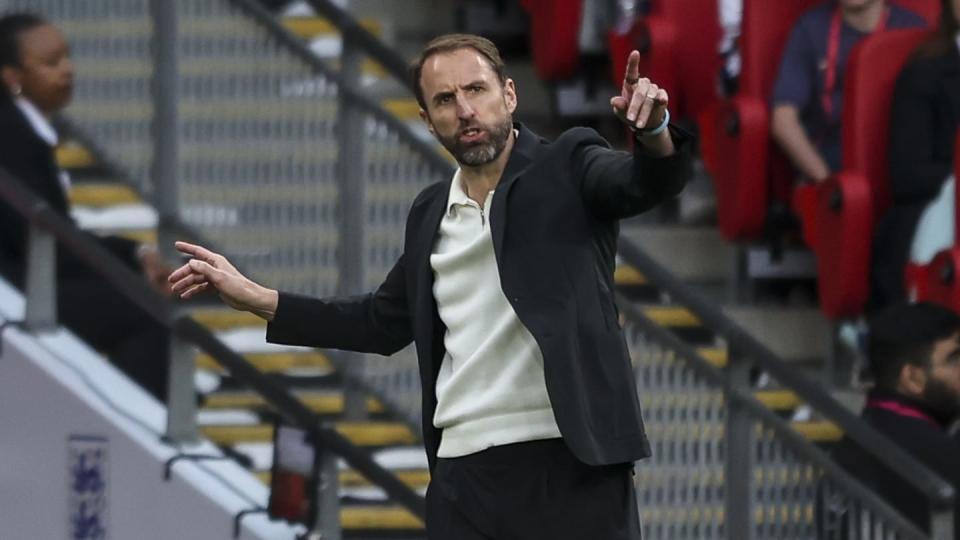A tactical analysis of Gareth Southgate's England team

Dubbed the 'impossible job', managing England has always been one of the trickiest gigs in football. That's something that Gareth Southgate can attest to.
The England gaffer has led the nation to some of their greatest moments at major tournaments, even reaching the semi-final of the 2018 World Cup and the final of Euro 2020 several years later, but that has not made him immune to criticism.
With one of the most talented England squads ever seen at his disposal, there are those suggesting that the Three Lions should be doing even better on the big stage. For many, Southgate's tactics have wasted a golden generation of attacking talent.
Here is a closer look at England's tactical setup under Southgate.
What formation does Gareth Southgate employ?
Having now spent almost eight years in the England dugout, Southgate has employed a variety of formations during his reign. However, the one that has brought most joy has been a variation of a 4-2-3-1, sometimes capable of becoming a 4-3-3.
This setup sees a flat back four with two sitting midfielders in front of the centre-halves. One of those will act as a traditional number six, breaking up play and recycling possession, while the other will perform in a more advanced position without straying too far forward.
Ahead of the holding midfielders there will be a number ten, a playmaker able of playing off the centre-forward. However, they will be expected to make runs beyond the striker, with England skipper Harry Kane - the guaranteed starter up top - often dropping into deeper positions.
Southgate doesn't want his wide players to play too centrally, but they wiill be given the freedom to drift into an inside forward position when required. In the likes of Bukayo Saka and Phil Foden, England have players who can be lethal in these positions. Flexibility across the front line means that the attacking midfielder can rotate with the wingers.
As mentioned, England play with an orthodox back four out of possession, operating in a mid-block. The two holding midfielders will drop deep to screen the back four, while the attacking midfielder will also have to track back, keeping close tabs on the opposition's playmakers.
The general idea, while not revolutionary, is to make the pitch as narrow as possible, congesting central areas and forcing the ball into wider positions. On the flanks, Southgate tends to opt for more traditional full-backs capable of winning one-v-one duels, hence why Trent Alexander-Arnold has struggled to leapfrog Kyle Walker in the pecking order.
In terms of pressing, England are not a high-intensity side. However, not many international teams are, and it certainly doesn't mean that the Three Lions don't apply pressure on the ball. England had a 14.33 PPDA (passes per defensive action) at the 2018 World Cup, with that figure having dropped to 9,24 PPDA at the most recent World Cup in Qatar. This highlights how Southgate has instructed his players to apply greater pressure to the ball when out of possession.
The main frustration for England supporters under Southgate has been a lack of attacking flair, despite the fact that England arguably boast the most formidable forward line in international football. A front four of Kane, Foden, Saka and Jude Bellingham is tantalising.
However, England are not a particualrly free-flowing side in possession. They struggle when teams set up in a low defensive block against them, often finding it difficult to break them down when space is limited. Given their quality, the majority of the teams they face will set up against them this way.
Generally, England are a possession focused team, which can sometimes be to their detriment. They will be patient in attack, recycling the ball and waiting for an opportune moment to strike. However, slowing play down doesn't help them cut through those low blocks, instead allowing the opposition time to organise themselves.
Even against the world's best sides, England tend to dominate the ball. They enjoyed 57% possession during their 2-1 defeat to France at the 2022 World Cup, while they boasted more of the ball against both Brazil and Belgium in recent international friendlies at Wembley. With the pace and technical class England have in the final third, a slightly more counter-attacking style may actually be beneficial.
However, it's worth noting that forward-thinking, high-intensity football is rarely a successful blueprint to follow at an international tournament. Defences are often the decisive factor on the big stage, with England's individual attacking quality capable of firing them to glory.

 Yahoo Sports
Yahoo Sports 
